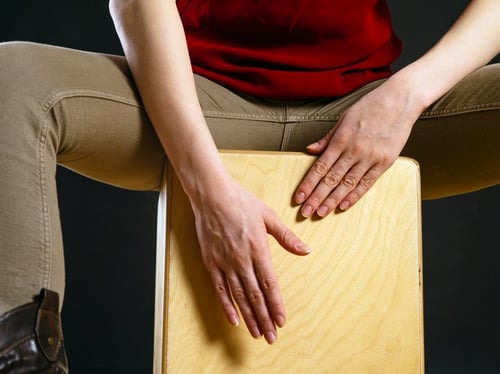What you Need to Know About Cajons
For percussionists, the drum set is the epicenter of rhythm and energy in a band, with drumsticks in hand setting the tempo and tone.
However, the bulk and complexity of transporting a drum kit can be challenging, especially for smaller venues or impromptu gigs.
Enter the cajon, a fantastic instrument and a practical alternative to the traditional drum set.
This box-like instrument offers percussionists a blend of rich tones, from bass drum sounds to snappy snare effects, all in a compact, portable package.
Let's explore the benefits of the cajon and what to consider when choosing this wonderful instrument for your musical endeavors.
Table Of Contents
- What is a Cajon?
- How To play a Cajon
- Look Into Playing Styles
- Use Your Ears, Not Your eyes
- Expand Your Percussion Knowledge
What is a Cajon?
Before diving into the world of cajon playing, let's define exactly what this fantastic instrument is.
The cajon, with its box-like structure, serves as both a seat and a musical instrument for the percussionist.
This percussion instrument is approximately 18 inches in height and 12 inches in width and is renowned for its rich tone and versatility.
Despite its seemingly simple design, the range of sounds a cajon can produce is genuinely remarkable.

Constructed primarily from hardwood, it features an additional layer of plywood, known as the tapa or face, which is the main striking surface.
The tone varies depending on where you strike the tapa with your hands, palms, and fingertips.
A distinctive feature of the cajon is the circular sound hole located on one side, usually positioned behind the player, allowing the sound to resonate outward.
Its compact size and weight make the cajon a fantastic instrument for travel and impromptu performances.
As you become more familiar with its nuances, you'll find it an invaluable addition to your musical repertoire, whether on stage or in a more intimate setting.
Originally from Peru, the cajon has a strong presence in Flamenco music.
However, its use has expanded into various musical genres, including folk, rock, jazz, and pop, making it a popular choice for diverse musical styles and settings.
How to Play the Cajon | How to Sit on the Cajon
Learning the proper technique for playing the cajon is essential to prevent discomfort and injury.
The most common approach is sitting directly on the cajon, leaning over to strike the front, or the cajon tapa with your hands.
This position allows cajon players to easily access the full range of tones, from the rich bass drum sound at the center to the snare drum-like sounds near the top.
Some percussionists prefer sitting behind the cajon on a drum throne or chair, straddling the instrument with their upper body.
Others slightly tilt the cajon towards them for a different angle of play.
The beauty of this box-like instrument lies in its adaptability to various playing styles and musical genres, from flamenco to rock music.
Discovering the position that works best for you is key.
Remember to prioritize health and safety by stretching before and during practice sessions.
Maintaining good posture is crucial; keep your back straight but relaxed to avoid strain.
This posture prevents discomfort and ensures you can effectively reach all areas of the cajon for a full spectrum of sounds, including the essential lower bass tones and crisp higher notes.
For additional information:
Look Into Playing Style
The cajon offers a rich tapestry of sounds that can rival a complete drum kit.
Understanding the different tones you can produce on this beautiful instrument is key to mastering its potential.
Despite the absence of a traditional bass drum, snare, or high hat, the cajon is far from limited.

The two primary tones you can create are the bass and high tones:
- Bass Tones: Achieved by striking the cajon's tapa (front section) about half a foot from the bottom, this technique produces a deep, resonant bass drum sound. Perfecting the bass tone requires practice, especially in maintaining a consistent rhythm while reaching the lower part of the cajon. But before you know it, you'll be playing some awesome cajon beats.
- High Tones: Tapping the upper corners of the cajon results in a higher pitch with less vibration, similar to the crisp sound of a snare drum. This versatile high tone allows for various rhythmic patterns and dynamic shifts.
Experimenting with palm orientation and finger techniques, such as using the finger pads or tips, opens up a world of rhythmic possibilities.
From staccato beats to muted tones, these stylistic variations can be mastered through dedicated practice and a deep understanding of the cajon's capabilities.
As a beginner cajon player, exploring these techniques lays a solid foundation for your journey into diverse musical styles, from flamenco to rock music.
The cajon's ability to produce awesome beats and rich tones makes it an amazing instrument for any percussion aficionado.
For some tips on techniques, click here.
Use Your Ears, Not Your Eyes

In the visually driven world of musical instruments, aesthetics often catch our eye.
However, when selecting a cajon, you must use your ears as much as your eyes.
While beautifully decorated cajons can be visually appealing, their appearance doesn't always correlate with sound quality.
Before making a purchase, it's essential to test the cajon. Don't let brand names or flashy designs sway your decision.
The quality of a cajon is influenced by factors beyond its exterior, with the type of wood being a significant determinant.
Different woods, like birch, oak, or pine, can impact the cajon's sound, producing tone, resonance, and projection variations.
Even cajons made from cheaper wood can surprise you with their rich tone and quality.
The key is to try them out personally. Have a friend play the cajon while you listen from a distance to truly gauge its sound.
Building your cajon could be a rewarding project for DIY enthusiasts, offering a personalized touch to your percussion arsenal.
One last piece of advice - remember to invest in a good case for your cajon.
Like all musical instruments, cajons are susceptible to wear and tear during travel.
Proper protection is vital to extend the lifespan of this amazing instrument and ensure it continues to produce its unique and captivating rhythms.
Expand Your Percussion Knowledge
If you love drumming and have done research for yourself, you are aware there are many percussion instruments beyond just the drum set and cajon.
However, the skills you learn can help you adapt to each and every instrument and provide experience going forward. If you want to be one of the greatest drummers of all time, you have to put the work and time in.

One great way to for you to learn rapidly and discover your true potential is attending a music school.
At the Atlanta Institute of Music and Media, we provide our students with an excellent drumming program that will connect you with experienced professors and allow you to network with other ambitious musicians.
Click the link below for more information on how AIMM's drum program can benefit you and your skillset today.













